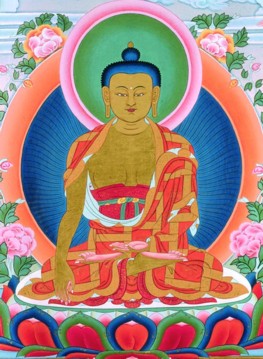Buddha Shakyamuni 釋迦牟尼佛
跳至導覽
跳至搜尋
Buddha Shakyamuni (Skt. Śākyamuni; Tib. སངས་རྒྱས་ཤཱཀྱ་ཐུབ་པ་, Wyl. sangs rgyas shAkya thub pa) — the Indian prince Gautama Siddhartha, who reached enlightenment (and thus became a buddha) in the sixth century B.C., and who taught the spiritual path followed by millions all over the world, known today as Buddhism.
目錄
Dates
Dates for the parinirvana according to:
- 2420 B.C.E. the Pandita Sureshamati
- 2150 B.C.E. the rGya-bod-yig-tshang
- 2146 B.C.E. Üpa Losal
- 2136 B.C.E. Atisha
- 2133 B.C.E. Sakya Pandita
- 949 B.C.E. The Blue Annals refering to a Chinese tradition from Fo-lin and accepted by the Japanese schools: Jodo, Jodo-Shinshu and Nichirenshu
- 881 B.C.E. Pakpa Lhundrup (followed by Butön and Dudjom Rinpoche)
- 876 B.C.E. Butön based on the Kalachakra tantra
- 835 B.C.E. Jonangpa school scholars
- 750 B.C.E. Tshalpa Kunga Dorje, based on the history of the Sandalwood Buddha
- 718 B.C.E. Kamalashila
- 651 B.C.E. Orgyenpa
- 544/543 B.C.E. Shakyashri, last abbot of Vikramashila
- 544 B.C.E. Theravadin tradition
- 489 B.C.E. based on the reign of Ashoka being 218 years after the parinirvana
- 486 B.C.E. "dotted record" which came to China through Samghabhadra
- 483 B.C.E. some modern scholars (an adjustment to the "dotted record")
- 386/383 B.C.E. modern Japanese scholars
- 371 B.C.E. based on the reign of Ashoka being 100 years after the parinirvana
Disciples
Further Reading
- Ashvaghosha, Buddhacharita (one of the most famous and inspiring accounts of Buddha's life)
- Dzongsar Jamyang Khyentse, What Makes You Not a Buddhist (Boston & London: Shambhala, 2007)
- Thich Nhat Hanh, Old Path White Clouds (Berkeley: Parallax Press, 1991)
- Tulku Thondup, Masters of Meditation and Miracles, edited by Harold Talbott (Boston: Shambhala, 1999), 'Shākyamuni Buddha'.
Oral Teachings Given to the Rigpa Sangha
- Dzogchen Rinpoche, Buddha’s Life and Path of Liberation, Lerab Ling, 6-7 June 1998
- Dzogchen Ponlop Rinpoche, Lerab Ling, 9 September 2011
Internal Links
- Mantra of Buddha Shakyamuni
- Twelve deeds
- Two images of Buddha Shakyamuni
- Quotations: Sutras, a collection of quotations from different sutras.
